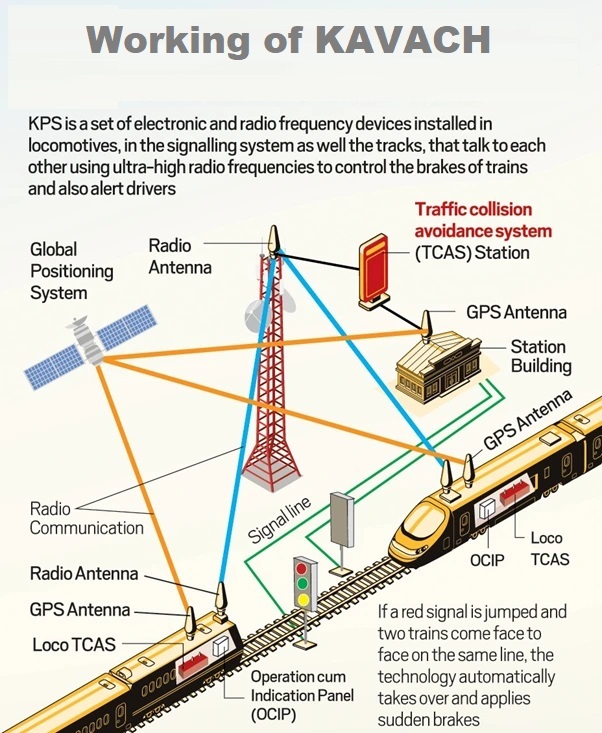Why in the News?
Indian Railways expects to launch Kavach CAS on Mumbai-Delhi-Kolkata routes by March 2025.
About Kavach Train Collision Avoidance System (TCAS)
|
Details |
| Development |
- Development started in 2011 by Indian Railways and Research Designs & Standards Organisation (RDSO).
- Key developer: B. Rajaram, known for the Skybus Metro system.
- Field trials began in 2014, and final approval was granted in 2019.
|
| Safety Parameters |
Certified for Safety Integrity Level 4 (SIL-4) operations |
| Working Mechanism |
- Components: Trackside RFID tags, onboard locomotive equipment, radio infrastructure.
- Functionality: Real-time monitoring, driver alerts, and automatic braking to prevent collisions.
- Data Inputs: Location, direction, time.
- Event Recorders: Retain records for post-incident analysis.
|
| Collision Prevention |
- Alert Mechanism: Alerts the locomotive pilot if a ‘red signal’ is missed.
- Automatic Braking: If speed exceeds 15 kmph after a red signal, Kavach applies brakes to halt the train.
|
| Issues |
- High Cost: ₹50 lakh per kilometer for deployment.
- Low Coverage: Covers only 1,500 kilometers out of the total 68,000-kilometer rail network (as of November 2023).
|

How does CAS work in ships and aircraft?
|
Key Systems |
Functions |
| Ships |
AIS (Automatic Identification System) |
Sends and receives data on location, speed, and direction between ships and land-based stations. |
| LRIT (Long Range Identification and Tracking) |
- Requires ships to report location, time, and equipment every 6 hours to authorities.
- Data shared with contracting governments and rescue operators via International LRIT Data Exchange.
|
| Aircraft |
Transponders |
Respond to radio-frequency pings to build a 3D view of surrounding air traffic. |
| Alerts and Resolution |
Issues alert if another aircraft is within 48 seconds (traffic advisory) or 30 seconds (resolution) of a collision. |
| Radar Altimeters and Obstacle Detection |
Monitors distance to the ground and alerts pilots about tall obstacles like towers. |
PYQ:
[2015] With reference to bio-toilets used by the Indian Railways, consider the following statements:
- The decomposition of human waste in the biotoilets is initiated by a fungal inoculum.
- Ammonia and water vapour are the only end products in this decomposition which are released into the atmosphere.
Which of the statements given above is/are correct?
(a) 1 only
(b) 2 only
(c) Both 1 and 2
(d) Neither 1 nor 2 |


